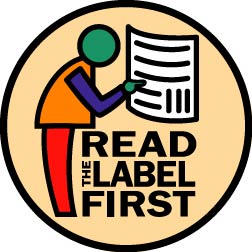
Labels and Rates
The admonition to “READ THE LABEL” is never as important as when dealing with insecticides. Everything you need to know about a product appears on its label. In fact, the label is really a legal contract between the manufacturer and the user. It is against the law to use any insecticide in a manner that is not totally consistent with the label information. By law, a label must contain all of the following information:
- Ingredients
- Each active ingredient must be listed by name. All other compounds (adjuvants) are grouped together as “Inert Ingredients”.
- Formulation and Concentration
- Alphanumeric designations give type of formulation and amount of active ingredient. For dry formulations, the concentration is given as a percent by weight (e.g., “20WP” is a wettable powder containing one pound of active ingredient in every five pounds of product). For liquid formulations, the concentration is given in pounds of active ingredient per gallon (e.g., “3EC” is an emulsifiable concentrate containing 3 pounds of active ingredient per gallon of product).
- Signal words
- The toxicity hazard of a pesticide is instantly recognizable by key words that appear in large type on the front panel of every label. The most hazardous pesticides bear the words “Danger” and “Poison” together with a skull and crossbones. Moderately hazardous compounds contain the word “Warning“, and compounds with only a slight hazard are designated with the word “Caution“.
- Legal Uses and Application Rates
- The label lists all legal uses of a pesticide, and gives the maximum application rate. It is against the law to use a pesticide for any purpose not listed on the label.
- Safety and Health Information
- The label specifies the type of protective equipment needed to apply the product safely. It also describes emergency actions that should be taken in case of accidental exposure or poisoning.
- Environmental Hazards
- Specific dangers to wildlife, ground water, or other components of the environment are listed on the label together with specific directions for avoiding those hazards.
- Disposal Instructions
- The label gives specific instructions on how to decontaminate and dispose of the empty pesticide container.

To use a pesticide correctly, you must be able to calculate the correct application rate.
- 1. If you want to apply one pound of active ingredient to an acre of soybeans, how much of a "50 WP" pesticide would you put into the sprayer?
- One-half pound
- One pound
- Two pounds
- Four pounds
- 2. If you want to apply one pound of the same active ingredient, but you are using a "3EC" formulation, how much would you put in the sprayer?
- Three gallons
- Two gallons
- One gallon
- One-third gallon
- 3. The label for a "10WP" formulation of Malathion says to apply two pounds of the formulation per acre. How much active ingredient would you be applying?
- Two pounds per acre
- 0.2 pound per acre
- 20 pounds per acre
- 0.4 pound per acre
- 4. In tree fruits, it is common to apply 200 gallons of water per acre in order to get good spray coverage of the foliage. Suppose a farmer has a two-acre block of trees that he plans to spray with a "50WP" formulation of Guthion. The label says to apply one-half pound of active ingredient per acre. How much water should he put in the tank and how much Guthion should he add in order to apply this insecticide correctly?
- One pound of Guthion in 400 gallons of water
- Two pounds of Guthion in 400 gallons of water
- One pound of Guthion in 200 gallons of water
- Two pounds of Guthion in 200 gallons of water
- 5. Four insecticide products are listed in the following table. Assume all four compounds are equally safe and equally effective at the recommended rates. Which one would be the most economical to use? (There are 2 pts/qt and 4 qts/gal)

